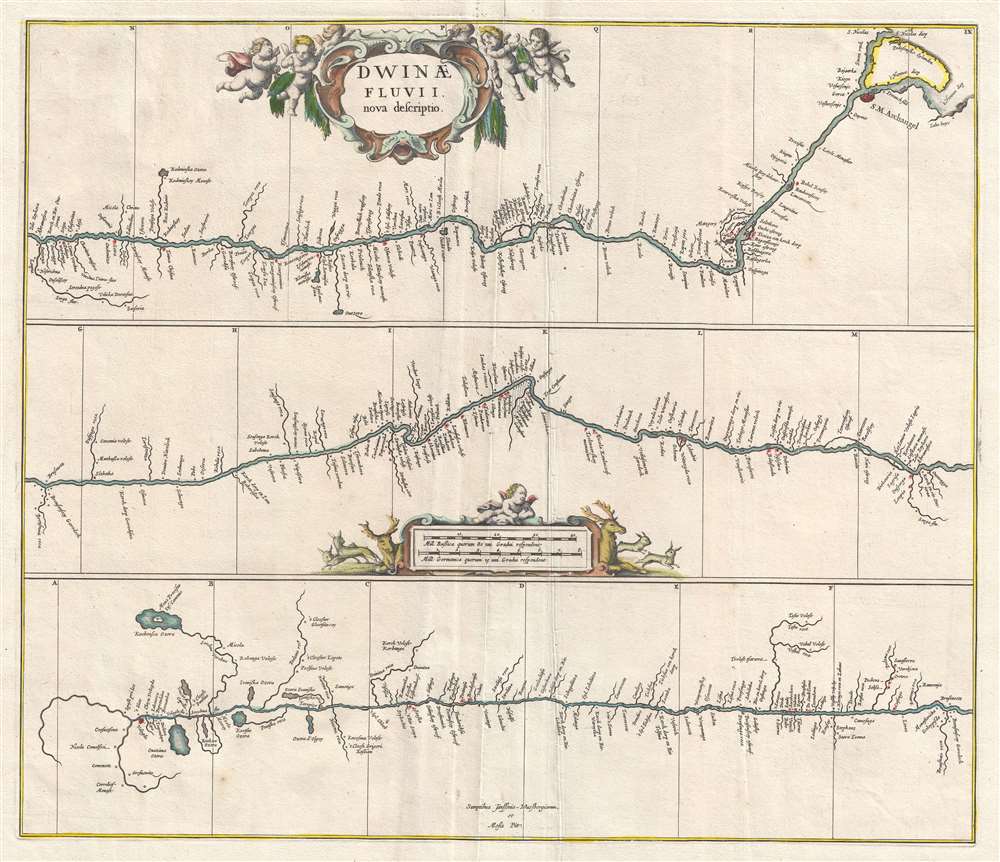1680 Jansson Map of the Northern Dvina River in Russia
DwinaeFluvii-jansson-1680
Title
1680 (undated) 19 x 22 in (48.26 x 55.88 cm) 1 : 623000
Description
The Northern Dvina River and International Trade
The Northern Dvina River was an important waterway used for fur trading. The Dutch first arrived in the North Sea near Arkhangelsk in the late 16th century. The river was later used by the Muscovy Company as the main trading route connecting Central Russia with Arkhangelsk. The Muscovy Company monopolized the English-Russian trade until 1698, after which the Dutch returned as dominant merchants in the region. Through all this, the Northern Dvina River remained an important trading route until the construction of the railway between Vologda and Arkhangelsk in the late 19th century. Today, the Northern Dvina River is used mostly to transport timber.Cartouche
A decorative title cartouche, flanked by putti, is situated along the top border, while a second cartouche located in the middle of the middle section of the river bears the scales and is adorned with illustrations of stags and rabbits.Publication History and Census
The map was created by Jan Jansson and published by his son-in-law Johannes Waesberger in conjunction with Moses Pitt in 1680. We note two examples cataloged in OCLC which are part of the collections at Harvard University and the Bibliothèque Nationale Universitaire de Strasbourg.CartographerS
Jan Jansson or Johannes Janssonius (1588 - 1664) was born in Arnhem, Holland. He was the son of a printer and bookseller and in 1612 married into the cartographically prominent Hondius family. Following his marriage he moved to Amsterdam where he worked as a book publisher. It was not until 1616 that Jansson produced his first maps, most of which were heavily influenced by Blaeu. In the mid 1630s Jansson partnered with his brother-in-law, Henricus Hondius, to produce his important work, the eleven volume Atlas Major. About this time, Jansson's name also begins to appear on Hondius reissues of notable Mercator/Hondius atlases. Jansson's last major work was his issue of the 1646 full edition of Jansson's English Country Maps. Following Jansson's death in 1664 the company was taken over by Jansson's brother-in-law Johannes Waesberger. Waesberger adopted the name of Jansonius and published a new Atlas Contractus in two volumes with Jansson's other son-in-law Elizée Weyerstraet with the imprint 'Joannis Janssonii haeredes' in 1666. These maps also refer to the firm of Janssonius-Waesbergius. The name of Moses Pitt, an English map publisher, was added to the Janssonius-Waesbergius imprint for maps printed in England for use in Pitt's English Atlas. More by this mapmaker...
Moses Pitt (c. 1631 - 1697) was one of the largest British book publishers, printers, and booksellers of the second half of the seventeenth century. A very ambitious man who's plans eventually led to bankruptcy, Pitt was a small bookseller and publisher before he embarked on some enormous, very expensive, ventures. The largest was the 'English Atlas', which he intended to contain 900 pages of text and 600 plates in eleven volumes, and partnered with Jan Jansson's heir Johannes Waesberger. The first volume was published in 1680, but rising costs contributed to only four volumes being published. Pitt's ambitions did not stop him there, as he began a huge property speculation scheme in Westminster and took over the printing office of Oxford University. By 1685, however, he was forced to sell of much of his stock at auction, which marks the end of his print publishing. His final bankruptcy and arrest for debt happened in 1689 and he spent the following eight years in prison, only to be released shortly before his death. Pitt published The Cry of the Oppressed: Being a True and Tragical Account of the Unparallel'd Sufferings of Multitudes of Poor Imprison'd Debtors In Most of the Gaols in England, an appeal on behalf of people imprisoned for debt, in 1691. Learn More...

